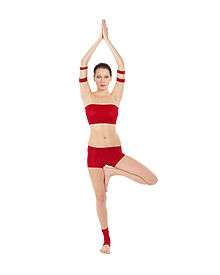Vriksasana

Vriksasana (vrik-SHAH-sə-nə[1]; Sanskrit: वृक्षासन; IAST: vṛkṣāsana) or Tree Pose[2] is an asana.
Etymology
The name comes from the Sanskrit words vriksa or vriksha (वृक्ष, vṛkṣa) meaning "tree",[3] and asana (आसन) meaning "posture".[4]
Description
From Tadasana, weight is shifted to one leg, for example, starting with the left leg. The entire sole of the foot remains in contact with the floor. The right knee is bent and the right foot placed on the left inner thigh, or in half lotus position. In either foot placement, the hips should be open, with the right knee pointing towards the right, not forward. With the toes of the right foot pointing directly down, the left foot, center of the pelvis, shoulders and head are all vertically aligned. Hands are typically held above the head either pointed directly upwards and unclasped, or clasped together in anjali mudra.
The asana is typically held for 20 to 60 seconds to stretch the spine, returning to tadasana while exhaling, then repeating standing on the opposite leg.[5]
Associated Mythology
Ravana, the mythical antagonistic king of Lanka in the Ramayana, kidnapped Queen Sita to make her his wife. He offered her anything she wanted, even proposing to make her his chief wife, only to be refused. Being used to getting his way, he had assumed that she would naturally fall for him, but she insisted that she was a prisoner and not a guest -- and that Rama, her husband, would find her and punish him. Determined, he told her that every day he would make the same proposition for a year, and if she didn't accept, at the end of the year, he would kill her and eat her. Until she accepted she was forced to live in the woods, under the ashoka trees around the palace. Every day his beastly servants would play with her head, taunting and tempting her to take Ravana's proposal and move into the palace with him, and every day she stood under the ashoka trees, breathing slowly, chanting Rama's name at every beat of her heart, and focusing on her drishti. Being the daughter of the Bhumi Devi -- the Earth itself -- she felted rooted and one with it. Symbols of patience, standing firm in times of change, and growing from within, the trees stood with her, until finally one day Rama sent Hanuman to find her.
Anatomical focus
The asana emphasizes alignment of the head, spine and hips.
Benefits
This asana improves:
- balance[6]
- Poise[6]
- posture[7][6]
- concentration[8]
- increases the range of motion in the hips[7]
- deepens the thorax[7]
- strengthens the ankles[7]
- tones the muscles of the legs, back and chest[7]
Contraindications and cautions
The sole of the lifted foot should be placed above or below the standing knee, but not directly on the side of it. Placing the foot adjacent to the knee places pressure on the leg in a direction which could cause injury because the knee does not flex parallel to the frontal plane. Additionally, raising the arms above the head for any length of time may involve risks for persons with high blood pressure. The arms can be held at chest height in anjali mudra for those at risk, or simply to relax the effort of the asana.
Beginner's tip
Focus the gaze on a small specific point, known in yoga as a drishte. This is ideally something directly ahead which does not move. Engage the standing foot by lifting the arch and pressing down through the lateral edge. Check that weight is distributed through the ball of the large toe, the ball of the small toe, and the heel. Draw in the navel to improve core stability and posture. Faults include leaning to one side, twisting, pushing one hip out; bending or rotating the supporting knee outwards; looking downwards and lacking concentration.[9]
See also
References
- ↑ Budilovsky & Adamson 2000, p. 150.
- ↑ "Yoga Journal - Tree Pose". Retrieved 2011-04-11.
- ↑ "Urdhva Vrikshasana - AshtangaYoga.info". Retrieved 2011-04-11.
- ↑ Sinha, S.C. (1 June 1996). Dictionary of Philosophy. Anmol Publications PVT. LTD. p. 18. ISBN 978-81-7041-293-9. Retrieved 9 April 2011.
- ↑ Silva & Methta 1990, p. 21.
- 1 2 3 Iyengar 1979, p. 62.
- 1 2 3 4 5 Hewitt 1983, p. 35.
- ↑ Hewitt 1983.
- ↑ Sivananda Yoga Vedanta Centre (1996) Yoga, Mind and Body (DK, London)
Sources
- Iyengar, B. K. S. (1 October 2005). Illustrated Light On Yoga. HarperCollins. ISBN 978-81-7223-606-9. Retrieved 9 April 2011.
- —— (1979). Light on yoga : yoga dipika (Rev. ed.). New York, N.Y.: Schocken Books. p. 544. ISBN 0-8052-1031-8. Retrieved 9 April 2011.
- Hewitt, J. (1983). The Complete Yoga Book. London: Random House.
- Budilovsky, Joan; Adamson, Eve (2000). The complete idiot's guide to yoga (2 ed.). Penguin. p. 368. ISBN 978-0-02-863970-3.
- Silva, Mira; Methta, Shyam (1990). Yoga: The Iyengar Way (1st ed.). New York: A.A. Knopf. p. 21. ISBN 0-67972287-4.
Further reading
- Saraswati, Swami Janakananda (1 February 1992). Yoga, Tantra and Meditation in Daily Life. Weiser Books. ISBN 978-0-87728-768-1. Retrieved 11 April 2011.
- Saraswati, Swami Satyananda (1 August 2003). Asana Pranayama Mudra Bandha. Nesma Books India. ISBN 978-81-86336-14-4. Retrieved 9 April 2011.
- Saraswati, Swami Satyananda (January 2004). A Systematic Course in the Ancient Tantric Techniques of Yoga and Kriya. Nesma Books India. ISBN 978-81-85787-08-4. Retrieved 9 April 2011.